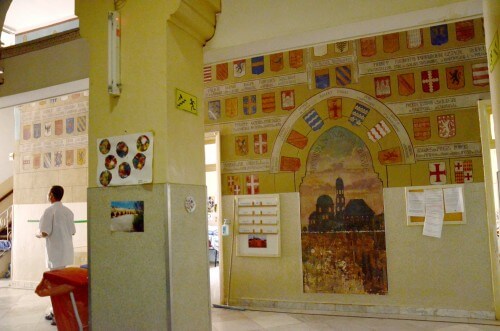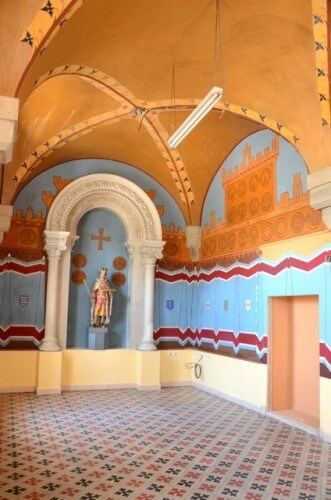The paintings, painted by a painter who founded the hospital in the 19th century, depict the Crusader knights wearing armor and wearing swords, and indicate, among other things, the genealogy of the French knights

Murals dealing with the Crusader history of Jerusalem were recently uncovered during a warehouse arrangement by the nuns of St. Louis Hospital, near the Old City of Jerusalem. In addition, the explosion of a water pipe in the building revealed paintings that were hidden under the modern plaster and paint.

Following the discovery of the paintings from the second half of the 19th century, depicting the Crusader period, the Antiquities Authority arrived on the scene and helped the nuns clean some of the paintings and stabilize them as first aid. The paintings are made in the style typical of monumental church decorations from the 19th century, paying attention to the small details and motifs borrowed from the world of Mediterranean art.
St. Louis Hospice - an impressive two-story building built in the Renaissance and Baroque style, located near the Jerusalem Municipality building and the crowded Tzahal Square, outside the walls of the Old City and in front of the New Gate. The place is named after Saint Louis IX (leader of the Seventh Crusade 1248-54) and was inaugurated in 1896. Today, parts of the building are not open to visitors due to its function as a hospital and hostel for the terminally ill and chronically ill.
The hospital is run by an order of merciful nuns called 'St Joseph of the Apparition'. This order treats patients of all religions, ages, and genders. Apart from the sacred work that is done on the spot, the building treasures a fascinating historical story, and an artistic treasure.
The initiator and founder of the hospital is a French count named Marie Paul Amédée de Piellat (Comte Marie Paul Amédée de Piellat), a man of many works, an intellectual and a devout Christian, who visited Jerusalem several times in the second half of the nineteenth century, and even died there in 1925 .
The landscape of the ancients of the Holy Land and Jerusalem in particular, were deeply engraved in De Failla's personality, and strengthened his Christian faith. De Failla was shocked by the meager Catholic presence in Jerusalem, and horrified by the rise in power of the Orthodox and their representatives in Jerusalem - the Russians. It should be noted that at that time, the great powers fought among themselves for control and religious hegemony in Jerusalem.
The count decided to take action, and between the years 1879-1896 he founded the hospital, which replaced a small and modest hospital in the Christian quarter inside the walls. Later he built another huge and magnificent complex nearby - Notre Dame de France, a hostel designed to serve the Christian pilgrims and meet their needs.
The Count's choice of the area to establish the hospital was not accidental. De Failla saw himself as a descendant of the Crusaders and as the last crusader. He wanted to continue the work of those Latin kings, knights and nobles, who stayed in Jerusalem about nine hundred years ago. Therefore, he chose to place the hospital in the historical area where the army of the Norman prince Tankard was camped, before he - together with his partners in the battle campaign - scored the walls of Jerusalem in 1099, and conquered it with storm and cruelty.
De Failla, who was also a craftsman, decorated the walls and ceiling of the hospital with huge paintings depicting the crusader knights in armor and carrying swords.
Alongside these giant figures, he drew the heraldry (symbols/signs) of the families of the French knights, wrote their names and indicated their genealogy. He also added the symbols of the Crusader cities, the symbols of the military orders and the monastic orders.
The sight was spectacular; The huge halls and endless rooms of the hospital are illustrated with the Crusader history of Jerusalem. During the First World War (the second decade of the twentieth century) the structure was in the possession of the Turks. These, paint the magnificent paintings black.
At the end of the war, the count returned to the hospital when he was dying. De Pailla devoted the rest of his time to peeling off the black paint and re-exposing the paintings. In 1925 he died in the hospital. A renewed interest in the lost and covered paintings has arisen recently, when the paintings were rediscovered in their full glory.
These magnificent paintings are a piece of history and a rare work of art. Now budgets are needed for their preservation, disclosure and documentation. On the other hand, it should be known that there is no intention to turn the place into a tourist site, in order to allow the continuation of the humble and quiet holy work that is done there.

2 תגובות
To Yossi, the place is operated by the church, but it is not religious (members of all religions stay there). It might be possible to open it to the public, but I do not expect the state to open an alternative institution.
It is beautiful even if it is not ours, and even if it is contrary without making you a statue and any mask.
It's an art. Israel should preserve it, and not wait for a budget from some world church.
I would like to see it open to the public.